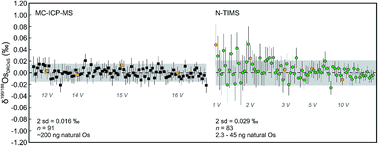High precision osmium stable isotope measurements by double spike MC-ICP-MS and N-TIMS†
Abstract
Osmium stable isotopes provide a new, potentially powerful tool with which to investigate a diverse range of geological processes including planetary formation, ore-genesis and weathering. In this paper, we present a new technique for high precision measurement of osmium (Os) stable isotope ratios by both Multiple-Collector Inductively Coupled Plasma Mass Spectrometry (MC-ICP-MS) and Negative ion Thermal Ionisation Mass Spectrometry (N-TIMS). We use a 188Os–190Os double spike, composed of 61% 188Os and 39% 190Os, to correct for mass dependent fractionation resulting from sample preparation and isotope measurement, with the ideal spike to sample ratio being 55 : 45. Isotope ratios are expressed as δ190Os which is the per mil deviation in the measured 190Os/188Os ratio relative to isotope reference material DROsS. Repeated analyses of double spiked DROsS for both MC-ICP-MS (n = 80 cycles) and N-TIMS (n = 280 cycles) show that an internal precision of 0.01–0.02‰ on δ190Os (2 se) can be attained, with a long-term reproducibility of 0.016‰ and 0.029‰ (2 sd; n = 91 and 83, respectively). The better reproducibility on MC-ICP-MS than on N-TIMS is, predominantly, due to measurement at higher beam intensities (11–18 V with consumption of ∼200 ng natural Os vs. 2–18 V with consumption of 2.3–45 ng natural Os, respectively). In addition to stable isotope compositions, our method allows for simultaneous measurement of 187Os/188Os and 186Os/188Os ratios with a precision of <40 ppm (2 se; 80 cycles for MC-ICP-MS and 280 cycles for N-TIMS) and an external reproducibility of 123–268 ppm and 234–361 ppm (2 sd; n = 91 for MC-ICP-MS and n = 83 for N-TIMS), respectively. We demonstrate that a similar precision and reproducibility can be obtained for other pure Os solutions as well as for geological materials. Furthermore, with a range of of analytical tests we evaluate and demonstrate the robustness of our method with regards to residual matrix effects and interference correction, signal intensity and on-peak zero on MC-ICP-MS, and the effect of oxygen corrections and isobaric interference on N-TIMS. Finally, we report the first Os stable isotope compositions for geological reference materials, including mantle peridotites and chromitites, and one ordinary chondrite.

- This article is part of the themed collections: JAAS Recent HOT articles and JAAS 2017 Most Downloaded Articles


 Please wait while we load your content...
Please wait while we load your content...